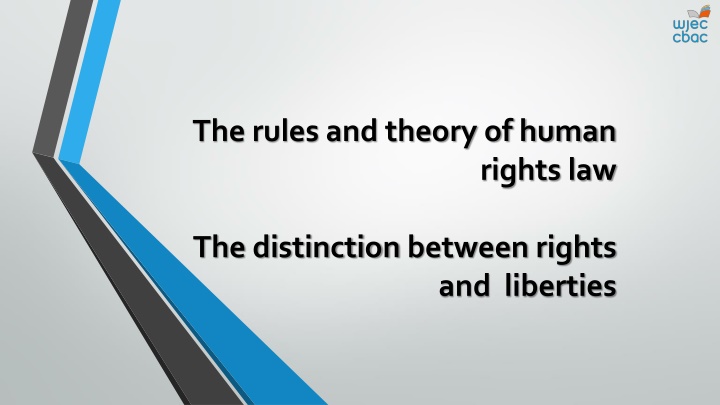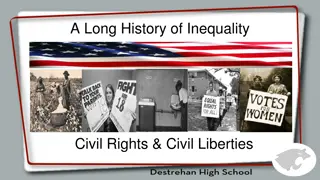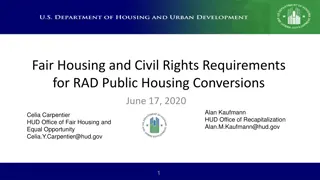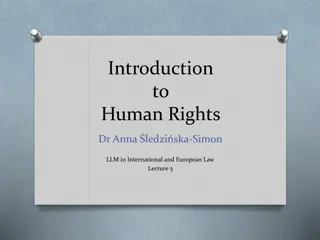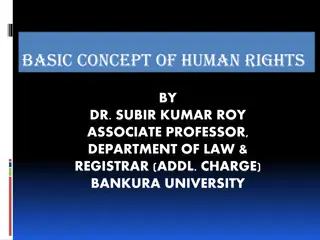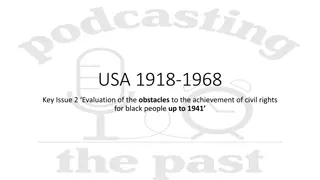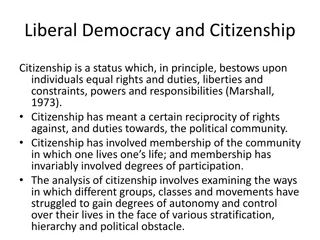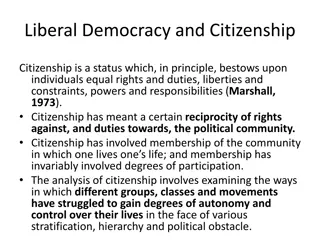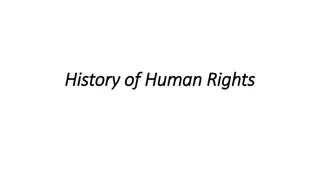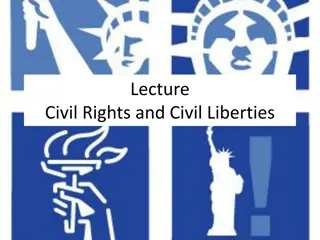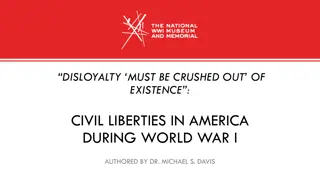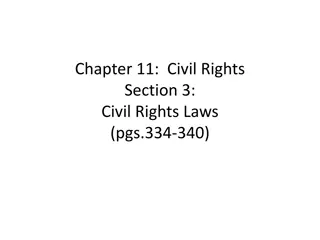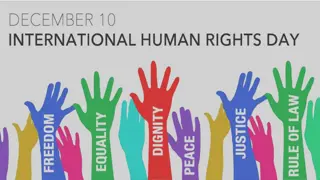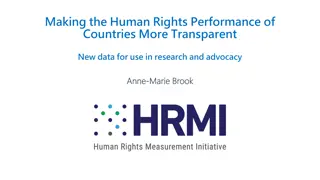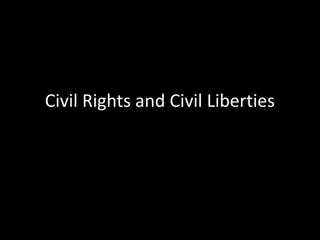Human Rights Law & Civil Liberties Distinction
The rules and theory of human rights law, the difference between rights and liberties, and the main theories like Locke, Rawls, Dworkin, and Bentham. Understand civil liberties, human rights, and how they are incorporated into domestic and international law. Dive into the origins of rights, values they promote, and how they are enforced, balanced, and enforced."
Download Presentation

Please find below an Image/Link to download the presentation.
The content on the website is provided AS IS for your information and personal use only. It may not be sold, licensed, or shared on other websites without obtaining consent from the author.If you encounter any issues during the download, it is possible that the publisher has removed the file from their server.
You are allowed to download the files provided on this website for personal or commercial use, subject to the condition that they are used lawfully. All files are the property of their respective owners.
The content on the website is provided AS IS for your information and personal use only. It may not be sold, licensed, or shared on other websites without obtaining consent from the author.
E N D
Presentation Transcript
The rules and theory of human rights law The distinction between rights and liberties
Objectives Define the terms human rights and civil liberties . Identify civil and political rights together with social and economic rights, giving examples for each one. Explain the distinction and similarities between rights and liberties. Explain the main theories - Locke, Rawls, Dworkina and Bentham. Explain how these theories are incorporated into both domestic and international law.
Rights and Liberties In small groups discuss the following: Where do rights come from? What values do they promote? What do you think is meant by human rights and civil liberties'? Give examples. How are rights balanced with other rights and collective issues? How are rights enforced?
Rights and Liberties Human rights and civil liberties - refers to rights/ moral claims that are seen as fundamental to an individual's liberty e.g. freedom of expression, freedom from torture and basic needs e.g. food, shelter. Human rights and civil liberties refer to those rights that are owed by the state to its citizens.
Civil Liberties Civil liberties - often refers to lists of civil and political rights e.g. those in the European Convention on Human Rights and the Human Rights Act 1998. Mainly negative in nature - obligations on state not to interfere.
Human Rights Human Rights - often refers to the state s obligation to provide the individual with basic needs of human life (often referred to as social and economic rights e.g. food, clothing, shelter and employment). Positive in nature.
Human Rights & Civil Liberties Distinction between the 2 is therefore twofold: State's negative (as opposed to positive) obligation to provide the rights, coupled with: The type of right in question e.g. civil/ political as opposed to social/economic. N.B. The two do overlap however, e.g. European Convention consists of mainly civil/political rights but does contain social/ economic rights e.g. the right to education.
Theories/Human Rights & Civil Liberties Basis of civil liberties is liberty of individual and protection from acts of arbitrary government. John Locke& Rawls - social contract - the state agreeing to respect individual choice e.g. on matters like religion, private life etc. These liberties/ rights are regarded as fundamental and superior to other rights/ interests.
Theories/Human Rights & Civil Liberties Under Lockeand Rawls social contract every person enters into a contract with the state, the state agreeing to protect the fundamental rights of its citizens. The citizen s promise of allegiance to the state - conditional on the state retaining these fundamental rights.
Theories/Human Rights & Civil Liberties Compare the social contract theory with the utilitarian theory stated by Jeremy Bentham -this theory does not see individual liberty as good per se and allows individual liberty being scarified for the greater public good if necessary.
Theories/Human Rights & Civil Liberties Ronald Dworkin believes the principle of equality is key to the theoretical basis for human rights protection. Dworkin believes every state has a duty to treat all of its citizens with equal concern and respect even those who have unpopular views. Do you agree?
Theories/Human Rights & Civil Liberties Protection of liberty and rights and the rule of law - under the rule of law, law should be open, clear, with equal application to all and great emphasis on due process. It states that the government should not interfere in an arbitrary way.
Theories/Human Rights & Civil Liberties Fundamental rights and liberties are found in both domestic and international law e.g. right to a fair trial, freedom of expression etc. are protected in a legal system's bill of rights and international treaties. Basic needs e.g. food, shelter etc. will be found in both the state s legal framework and international treaties.
Theories/Human Rights & Civil Liberties Protection of social and economic rights - not usually offered the same level of protection as civil and political rights (judiciary given special duty under the Human Rights Act 1998 to safeguard civil/ political rights from excessive interference). However both sets of rights are fundamental even though they may be enforced differently.
Test yourself 1. What is the main difference between human rights and civil liberties? 2. Give some examples of civil/ political rights and human rights. 3. What was the theory put forward by Locke and Rawls? 4. How did Bentham disagree with their theory? 5. For Dworkin, what was the key to the protection of human rights?
